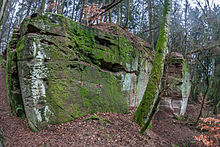Fürth
![]()
This article is about the city of Fürth in Franconia, for other meanings see Fürth (disambiguation).
Fürth (Franconian: ![]() , Yiddish: פיורדא|Fiurda) is a district-free city in the Bavarian administrative district of Middle Franconia. It forms a triangle of cities with Nuremberg and Erlangen, the core area of the Nuremberg conurbation, which includes Schwabach. Together with the surrounding area, this is the Nuremberg Metropolitan Region, one of three metropolitan regions in Bavaria, or eleven in Germany.
, Yiddish: פיורדא|Fiurda) is a district-free city in the Bavarian administrative district of Middle Franconia. It forms a triangle of cities with Nuremberg and Erlangen, the core area of the Nuremberg conurbation, which includes Schwabach. Together with the surrounding area, this is the Nuremberg Metropolitan Region, one of three metropolitan regions in Bavaria, or eleven in Germany.
With a population of over 132,000, the city is the second largest in Franconia and the sixth largest in Bavaria - after Munich, Nuremberg, Augsburg, Regensburg and Ingolstadt.

Fürth seen from the tower of the town hall, on the right the Michaelis church
Geography
Location and area
The historic city centre is located east and south of the rivers Rednitz and Pegnitz, which flow together northwest of the old town to form the Regnitz. To the west of the city, beyond the south-west bypass and the Main-Danube Canal, the Fürth city forest rises. To the east of the city lies the directly adjoining city of Nuremberg at about the same altitude. To the north is the fertile Knoblauchsland, which partly belongs to the city area. South of the city lies a mixed area of wide motor roads, canal and river meadows.
The highest point of the terrain is the quarry in Burgfarrnbach with 392.3 m above sea level, the lowest is in the Regnitztal at the city border to Erlangen at 278 m above sea level, the city hall in the city center is at 294.9 m above sea level.
The area of the city area is 63.36 km², the length of the city boundary 50.05 kilometers. The distance between the easternmost and westernmost point of the Fürth city area is 9.835 kilometres, between the northernmost and southernmost point 11.704 kilometres.
Neighboring communities
The following cities and municipalities border the city of Fürth, they are named clockwise starting in the north:
Erlangen and Nuremberg (both district-free), Oberasbach, Zirndorf, Cadolzburg, Seukendorf, Veitsbronn and Obermichelbach (all district of Fürth).
City breakdown
For the division of Fürth into boroughs and districts see: List of city districts and statistical districts of Fürth.
The political municipality has 21 officially designated parts of the municipality (the settlement type is indicated in parentheses):
- Atzenhof (village)
- Bislohe (village)
- Braunsbach (village)
- Burgfarrnbach (district)
- Dambach (district)
- Flexdorf (village)
- Fürth (main town)
- Herboldshof (village)
- Kronach (village)
- Mannhof (Pfarrdorf)
- Oberfürberg (village)
- Poppenreuth (parish village)
- Ritzmannshof (village)
- Ronhof (village)
- Sack (church village)
- Stadeln (district)
- Steinach (village)
- Unterfarrnbach (village)
- Unterfürberg (village)
- Vach (district)
- Weikershof (village)

enlarge and show information about the picture
![]()
Fürth panorama from the "Solarberg" ( ![]() 49.510310.96232) looking southeast, May 2017. Among others, the church St. Michael and the town hall can be seen in the left part of the picture, the churches St. Heinrich and St. Paul, the high-rise buildings Bahnhofcenter and the Sparkassenhaus, and behind the town hall the two high-rise buildings in the Nuremberg district Röthenbach in the right part of the picture.
49.510310.96232) looking southeast, May 2017. Among others, the church St. Michael and the town hall can be seen in the left part of the picture, the churches St. Heinrich and St. Paul, the high-rise buildings Bahnhofcenter and the Sparkassenhaus, and behind the town hall the two high-rise buildings in the Nuremberg district Röthenbach in the right part of the picture.
Nature
The urban ecology nature trail was established in 1999 (three kilometres, ten stations) and extended in 2003 to include a Route B (seven kilometres, ten stations). The starting point for both tours is the Stadthalle underground station. Along the trail, individual habitats are explained in terms of their importance for flora and fauna (e.g. St. Michael's churchyard, municipal cemetery, Scherbsgraben); reference is made to the designation of certain areas as landscape conservation areas and to the problems associated with measures that alter the environment, such as river straightening. The average sunshine duration is 1766 hours per year.
The Gustav Adolph Spring is located near Weikershof, right on the Rednitz River. It was revived in 2000 and equipped with a pavilion. Until 1953, the spring water with its 19 degree warm water was used in a nearby swimming pool. Since its demolition, the water, 160 litres per minute, flowed unused into the river. Due to the faint smell of hydrogen sulphide, the spring is also called Gaggerlasquelle (Franconian dialect for "egg spring").
The 560-hectare Fürth city forest is home to rare animal species and is therefore a Special Protection Area of European Interest in the Natura 2000 habitat network. The forest consists largely of pines intermixed with deciduous trees. In the quarries in the Fürth city forest, castle sandstone was quarried as an important building material until the Middle Ages. Among others, various bat species (brown long-eared bat, fringed bat and water bat) and the black woodpecker live in the city forest.
→ Main article: Fürth city forest
In Fürth there are thirteen designated landscape conservation areas, one geotope and two designated FFH areas. (as of January 2016)
See also:
- List of protected landscape areas in Fürth
- List of FFH areas in the city of Fürth
- List of geotopes in Fürth

Quarry in the Fürth city forest

Pegnitz (river), a new river bend created in 2003, from northeast
Search within the encyclopedia